Cambodia is a nation in Southeast Asia that has outstanding natural beauty. The nation has been a battlefield for a large portion of its history between many countries and political factions. It was attempted to be rebuilt at the turn of the century after decades of civil strife. The changes in the Cambodia flag followed those historical events.
In this article, we will explore and learn more about the difficult history of the Cambodia flag.
Location Of Cambodia
Border countries and geography play an important role in the formation of a country’s national emblem, and the Cambodia flag is no exception. Vietnam, Laos, and Thailand all border Cambodia. The Gulf of Thailand is located southwest of the country. Central Cambodia is covered by a low-lying plain. The Mekong River flows over mountains in the east. In the west are the mountains and Tonle Sap (the Great Lake).
A tropical climate with a wet and dry season is present in Cambodia. The lowlands seldom see temperatures below 80 °F (27 °C). The country adheres to UTC+07:00. Cambodia used a local mean time before 1920. However, since time in Cambodia does not follow daylight saving, it was replaced by Indochina Time (ICT), which is UTC+07:00.
About 97 percent of the people are of Khmer ethnicity. Cambodia is home to Chinese, Vietnamese, and Cham people as well. Buddhism is the dominant faith. Ancient folk religions are also practiced by a large rural population. The majority of people, nearly 80%, live in rural regions.
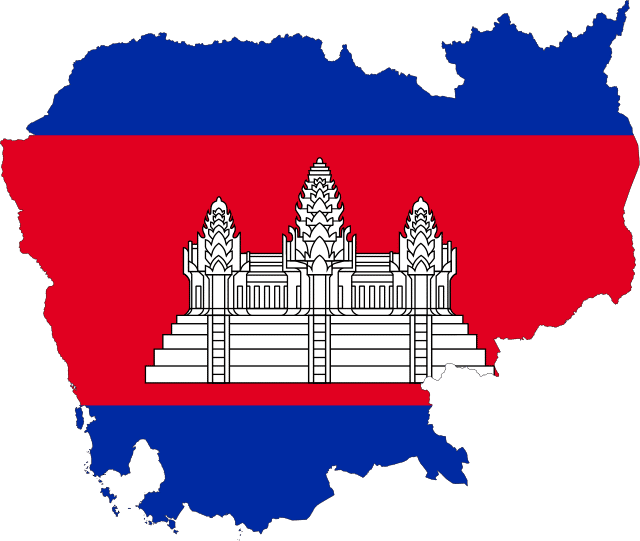
Important Milestones Of Cambodia History
The Cambodian flag was altered and changed numerous times. The country went through many wars and troubles. Every time a new conqueror came to rule, a new flag was introduced. The Khmer Kingdom ruled over Cambodia from 900 to 1400 AD, which is considered to be the most illustrious era in its history. For a period of its history, the Khmer Kingdom governed the region and was Southeast Asia’s biggest empire.
At the height of their supremacy, more than a million people probably resided in the capital city of Angkor. The most well-known of the magnificent temples built here is Angkor Wat. The Khmer Kingdom fell apart in the fifteenth century and never recovered its previous splendor.
France began to protect Cambodia in 1863. Up until November 9, 1953, when it attained complete independence, this persisted for over a century. However, after the war, things only became worse.
In 1989, Vietnam withdrew from the nation, which was then known as Cambodia. Inhumane working conditions were pressed upon the populace, and 1 million Cambodians, or about 12% of the total, were slaughtered.
The Khmer Rouge was outlawed by a new Cambodian government in 1993. The Khmer Rouge, however, continued to battle until Pol Pot’s assassination in 1998. Many individuals believed that the Khmer Rouge leaders should be tried for their actions in the 1970s.
Beginning in the year 2000, Cambodia started to stabilize. It improved its economy by joining organizations for commerce and business on a global scale. Political squabbles persisted, though. 2009 saw the start of the first Khmer Rouge official trial. Only three individuals were put to the test for ten years. They were all found guilty of crimes against humanity, and two of them also had genocide convictions.
History Of Cambodia Flag
Since the middle of the 19th century, there have been 10 separate flag revolutions, totaling ten different Cambodia flags. It was originally implemented in 1948, while the country was still a French colony, and it was maintained in 1953 when it gained its independence from France. Upon the founding of the Khmer Republic in 1970, a new flag was chosen.
After then, six more official flags were flown. UNTAC flag, which was flown from 1992 to 1993 until Cambodia was reestablished in 1993 and the country’s royal system was restored. Before 1863, the yellow triangle pennant flown by the “Kingdom of Cambodia” had a substantial green border surrounding it.
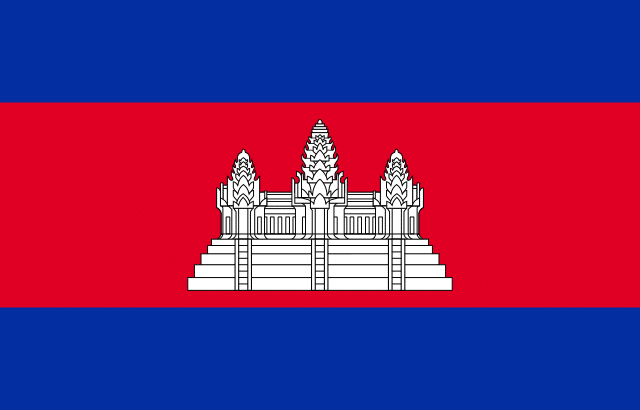
Cambodia As French Protectorate
When it became a French colony in 1863, the Kingdom of Cambodia was a protectorate. The acceptable flag included a white image of Angkor Wat in the center of a red field, encircled by a large blue border.
The Indochinese Federation, governed by France, was established in 1887 and encompassed Cambodia as well as Annam, Tonkin, and Cochinchina. To celebrate the union, the French tricolor flag was flown over the national flag of Cambodia.
In March 1941, when the Japanese took control of Cambodia, they established a red backdrop with a large square in the middle overlaying a smaller square. They also used the four corners of the square to connect the dots, and it was used as an official flag during that time. After Japan was defeated in World War II in 1945, the French Protectorate’s flag was reinstated.
When Cambodia gained political independence from France in 1953, a flag with the same form as the current one was authorized for use. This design featured a white Angkor Wat during a crimson field with blue ribbons running across the top and bottom.
Khmer Republic
The country was given the name Khmer Republic, and it had an authoritarian administration following an army revolt in 1970. The flag had a large blue backdrop with three white stars in the top right corner and a white Angkor Wat enclosed in a red rectangle on the upper left.
When Pol Pot, the leader of the Khmer Rouge, gained control of the country in 1975, he renamed it Cambodia Democratic Kampuchea. The three-towered Angkor Wat-inspired castle on the pol pot flag is set against a plain red background.
After the Vietnamese took over the country, the Salvation Front seized power and founded the People’s Republic of Kampuchea. The central portion of the Cambodia flag had yellow towers with red backgrounds that are reminiscent of Angkor Wat.
When the Khmer people joined the State of Cambodia on January 1, 1990, the official elaborated yellow depiction of Angkor Wat had a background made of a horizontal blue and red bicolor.
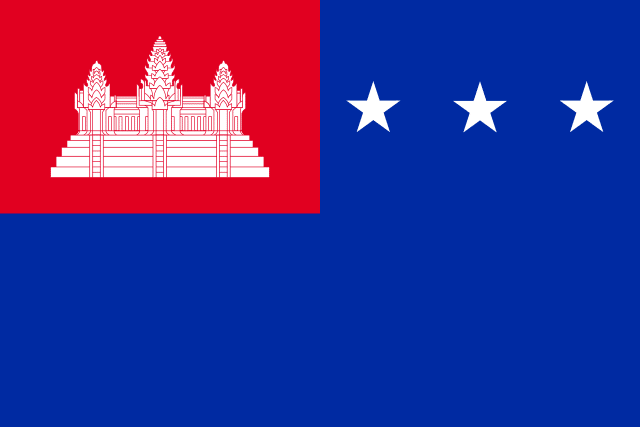
UNTAC Cambodia Flag
In an effort to bring peace back to Cambodia, the UN retook control of the nation’s administration in 1992. The UNTAC flag had a white nation map in the center with the word “Kampuchea” printed in blue and a light navy blue background.
The United Nations is a peacemaker to preserve international harmony. A nation that had been destroyed by years of conflict needed stability; thus, UNTAC was founded. It was the first time in the history of that country that an organization successfully took control of the government of a sovereign state and arranged and performed an election.
When premier elections were held following the Khmer Rouge and the monarchy was reinstated in 1993, the post-French sovereign flag was created. And the flag has been flown with this design up until this point.
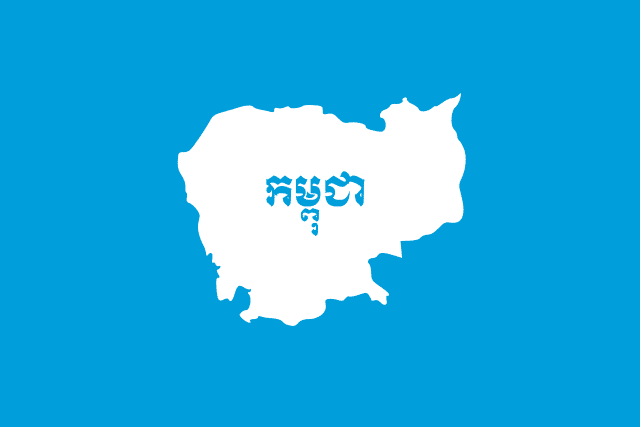
Cambodia Flag Design
The Cambodia flag has a rectangular shape. It includes a horizontal band with a 25:16 aspect ratio. The top and bottom of the flag are blue, while the center is red. These two colors make up its overall look. Additionally, the blue stripe is half as wide as the red one. In addition, the middle of it features a white image of Angkor Wat, Cambodia’s national symbol.
Symbolism Of Cambodia Flag
The colors of the Cambodia flag are particularly significant to the nation. As a result, the color of the Cambodia flag and the image of the temple on the band decide its meaning. Looking closely at the flag, its color, and the Angkor Wat design reveals its meaning.
Through its representation of Angkor Wat, the Cambodia flag expresses the country’s sense of justice, history, and integrity. It also has a significant religious and historic effect on the Khmer people.
The white hue of Angkor Wat stands for the nation’s beliefs and religions, particularly Buddhism and the value of the universe’s dignity. The two bands of blue symbolize the sentiments of independence, allegiance, and unity. It also represents the monarchy and the King. Bravery is symbolized by the color red. It indicates that the nation has endured a traumatic history of conflicts and wars.
Coat Of Arms Of Cambodia
The Cambodian monarchy is represented by its royal arms. Since 1953, when the Kingdom of Cambodia became an independent nation, they have existed in some form. It appears on King Norodom Sihamoni’s (the current king of Cambodia) royal banner.
On two ceremonial pedestal plates (phan), a light blue shield with an Unalome sign—the Khmer equivalent of the Aum symbol—on top of the sword and a laurel wreath with the Royal Order of Cambodia overlaid on the bottom are placed. The shield is affixed to a white cloak with golden fringes and ornaments on the bottom. It is crowned with a brilliant diamond that glistened in the light rays of the crown’s peak.
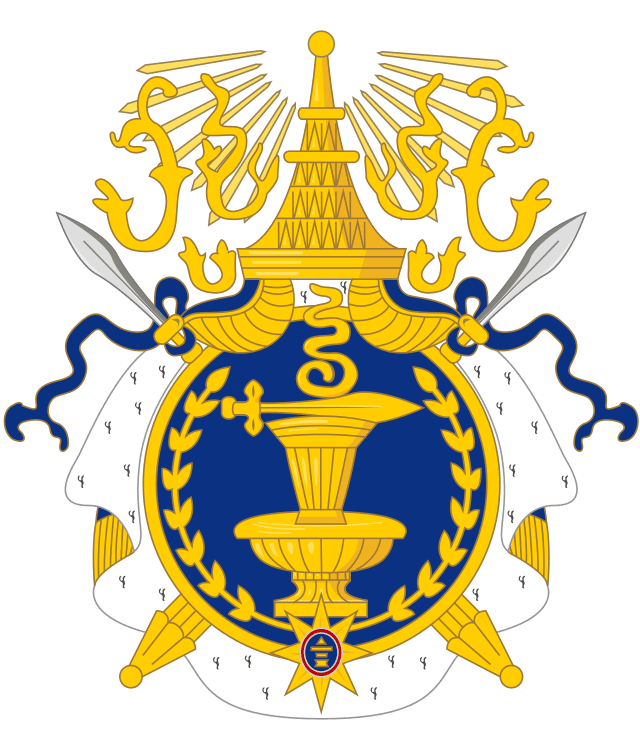
Bottom Line
Above, we learned more about the history and development of the Cambodia flag. Since 1863, Cambodia’s national flag has changed numerous times. The only nation with a building on its flag among the 195 nations that make up the globe is Cambodia. It is a representation of the legendary Angkor Wat and stands for justice, character, and legacy.